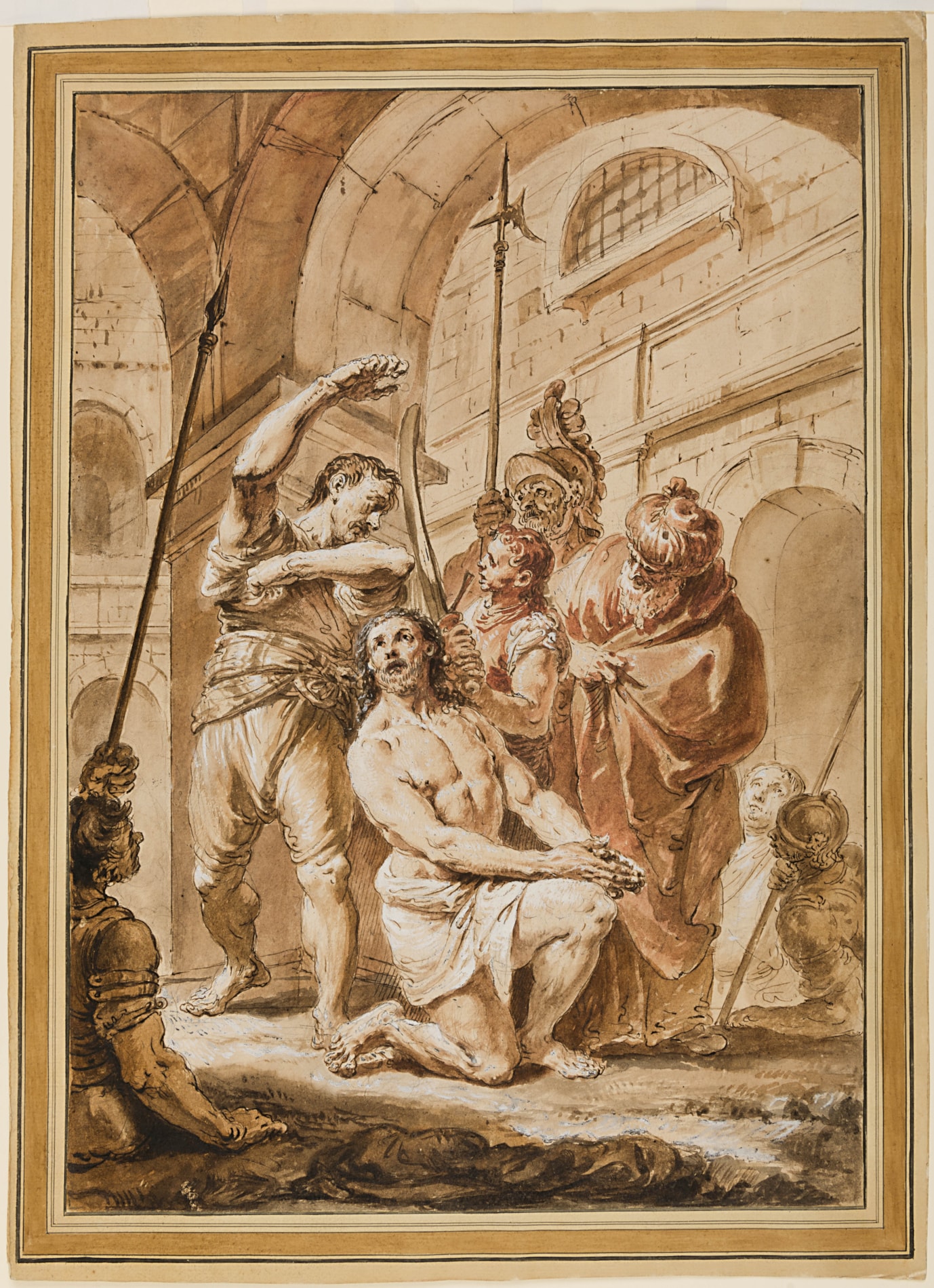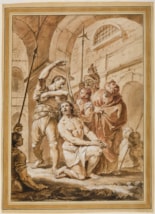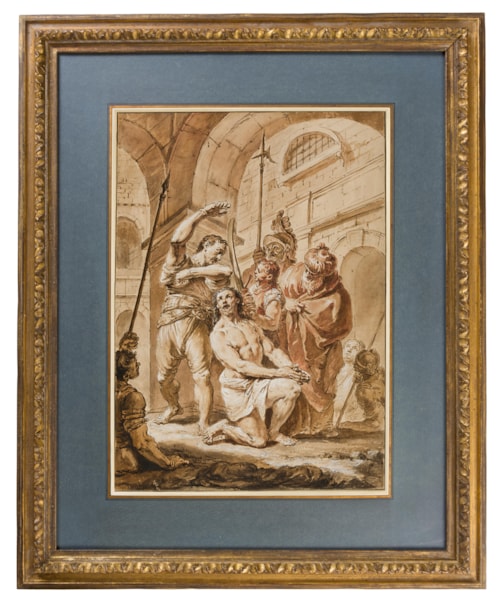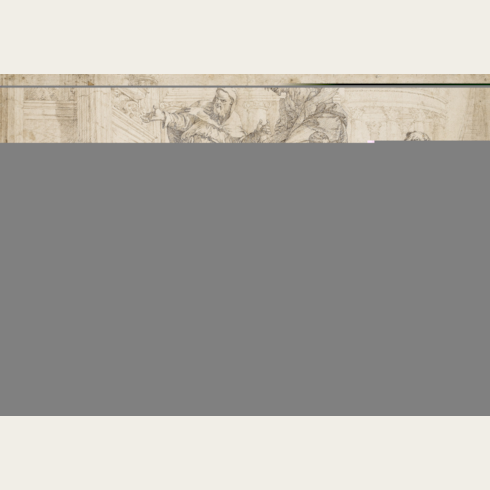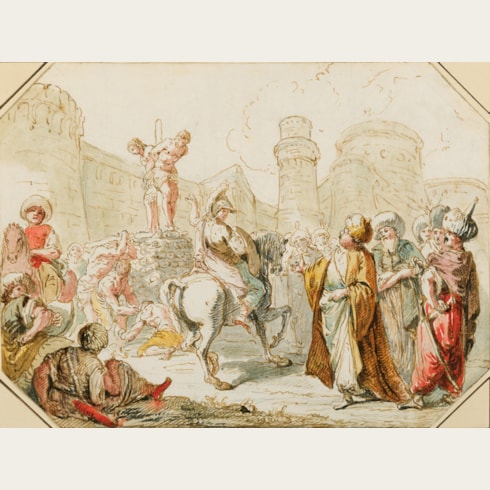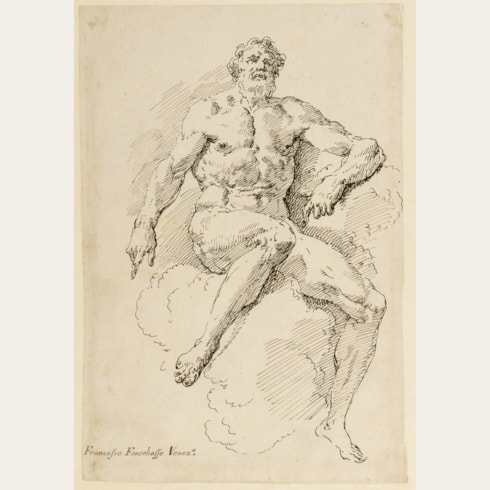Francesco FONTEBASSO
(Venice 1707 - Venice 1769)
The Martyrdom of Saint James the Greater
Sold
Pen and two shades of brown ink and brown wash, heightened with white and with touches of red wash, over an underdrawing in black chalk.
Laid down on a 19th century mount.
Inscribed Di Francesco Fontebasso Veneziano at the lower right.
Further inscribed Di Francesco Fontebasso Veneziano M 281 and numbered 2923 on the backing sheet.
464 x 330 mm. (18 1/4 x 13 in.)
Laid down on a 19th century mount.
Inscribed Di Francesco Fontebasso Veneziano at the lower right.
Further inscribed Di Francesco Fontebasso Veneziano M 281 and numbered 2923 on the backing sheet.
464 x 330 mm. (18 1/4 x 13 in.)
Francesco Fontebasso’s drawings are, like his paintings, best described as a synthesis of the manner of his teacher Sebastiano Ricci with the style of Giambattista Tiepolo. As the scholar Filippo Pedrocco notes, ‘at different stages of his career his graphic work sometimes reflects the influence of one, sometimes the other. He was not simply a passive interpreter of their work, however, and was capable of achieving a high degree of poetry independent of their influence. Examples can be found among his many ‘finished’ drawings, evidently intended for collectors.’ Indeed, Fontebasso helped to develop the taste for refined, pictorial drawings that became a distinctive feature of Venetian draughtsmanship from the middle of the 18th century onwards.
Most of Fontebasso’s drawings are executed in pen and ink, and while relatively few may be connected with his paintings, several can be related to the handful of etchings that he made. Perhaps the most significant examples of the artist’s draughtsmanship, however, are a group of large and highly finished drawings that were produced as independent works of art. Notable among these are a parallel series of scenes and subjects from the Old and New Testament, of which the present sheet is a fine example, and another distinct group of episodes from ancient and classical history. Vertical in orientation, these highly finished works are drawn with a combination of pen, ink and coloured washes.
Fontebasso’s large-scale drawings of both Biblical and historical subjects, as James Byam Shaw has pointed out, share ‘the same finish, the same elaborate composition, the same architectural backgrounds – the classical arches, the curving colonnades, the pedimented temples, the domes, the towers…None of these drawings is signed, and one would hardly expect them to bear any direct relationship to Fontebasso’s paintings – for they are pictures in themselves, even though they were probably intended for the album of the amateur, rather than for the wall. No one, however, will doubt that Fontebasso was the draughtsman; the type of composition, deriving, through Sebastiano Ricci, from Paolo Veronese, the lighting, the draperies, and the morphological details…are exactly as we find them in his paintings.’
The present sheet depicts Saint James the Greater, one of the twelve Apostles and the only one whose death is recorded in the New Testament. James preached the gospel in Samaria and Judea, and possibly also in Spain. During Passover of 44 AD, James was arrested in Jerusalem on the orders of King Herod Agrippa and beheaded, the first of Jesus’s disciples to suffer martyrdom. (‘It was about this time that King Herod arrested some who belonged to the church, intending to persecute them. He had James, the brother of John, put to death with the sword. When he saw that this met with approval among the Jews, he proceeded to seize Peter also. This happened during the Festival of Unleavened Bread.’; Acts 12:1-3.) James’s body was transported by his followers to Iberia, and his remains are said to be enshrined in the cathedral of Santiago de Compostela in Galicia. Saint James is today the patron saint of Spain.
‘Presentation’ drawings such as this by Fontebasso, which have generally been dated to around 1750, represent his distinctive contribution to the Venetian artistic tradition of producing highly finished drawings as independent works of art, as seen for example in the earlier gouache landscapes of Marco Ricci or the teste di carattere of Giambattista Piazzetta. This group of finished drawings by Fontebasso also anticipates three series of sizeable folio drawings – the ‘Large Biblical Series’, the ‘Scenes of Contemporary Life’, and the Punchinello sequence entitled Divertimenti per li regazzi – produced by Domenico Tiepolo later in the century.
The fact that none of these drawings by Fontebasso are signed suggests that they may have been intended to be compiled into one or more albums for collectors, like the later drawings by Domenico Tiepolo. This is the case with a group of twenty-eight large drawings of Biblical subjects by Fontebasso that was discovered, bound into an 18th century album, in a Parisian bookshop in 1934 and is today in the collection of the Museo Correr in Venice. As Andrew Robison has noted, ‘Fontebasso’s series of biblical and ancient history drawings represent a further development in the Venetian production of drawings not only as studies or preparatory designs but also as finished, independent works of art...The drawings in the Fontebasso series are quite elaborate, clearly meant to be valued and collected as autonomous works of art, and seem to be intended in narrative sequence…Fontebasso may well have intended all these finished drawings not to circulate as single sheets or in small groups, like the finished sheets by Marco Ricci, Piazzetta, and Tiepolo, but to be bound together in one or two albums. Such albums would be just contemporaneous with the thematic albums Giambattista Tiepolo was forming. The size and high finish of Fontebasso’s works would also create a precedent for the later series by Giandomenico Tiepolo.’
Apart from the Museo Correr album, other examples of large and highly-finished pictorial drawings of this distinctive type by Fontebasso are today in the collections of the Art Institute of Chicago, the Statens Museum for Kunst in Copenhagen, the Courtauld Gallery in London, the J. Paul Getty Museum in Los Angeles, the Staatliche Graphische Sammlung in Munich, the Ashmolean Museum in Oxford, the Musée du Louvre in Paris, the Hermitage in St. Petersburg, the Albertina in Vienna and the National Gallery of Art in Washington, D.C., as well as in a number of private collections.
Drawings by Fontebasso of a similar subject, though different in composition, include a pen and ink sheet in the Galleria dell’Accademia in Venice and two related, large presentation drawings of the martyrdom of a male saint; one in a private collection in California and the other in the Ashmolean Museum in Oxford. Also similar in theme is a large sheet depicting The Beheading of a Male Saint, which is part of the album of Biblical drawings by Fontebasso in the Museo Correr in Venice.
Most of Fontebasso’s drawings are executed in pen and ink, and while relatively few may be connected with his paintings, several can be related to the handful of etchings that he made. Perhaps the most significant examples of the artist’s draughtsmanship, however, are a group of large and highly finished drawings that were produced as independent works of art. Notable among these are a parallel series of scenes and subjects from the Old and New Testament, of which the present sheet is a fine example, and another distinct group of episodes from ancient and classical history. Vertical in orientation, these highly finished works are drawn with a combination of pen, ink and coloured washes.
Fontebasso’s large-scale drawings of both Biblical and historical subjects, as James Byam Shaw has pointed out, share ‘the same finish, the same elaborate composition, the same architectural backgrounds – the classical arches, the curving colonnades, the pedimented temples, the domes, the towers…None of these drawings is signed, and one would hardly expect them to bear any direct relationship to Fontebasso’s paintings – for they are pictures in themselves, even though they were probably intended for the album of the amateur, rather than for the wall. No one, however, will doubt that Fontebasso was the draughtsman; the type of composition, deriving, through Sebastiano Ricci, from Paolo Veronese, the lighting, the draperies, and the morphological details…are exactly as we find them in his paintings.’
The present sheet depicts Saint James the Greater, one of the twelve Apostles and the only one whose death is recorded in the New Testament. James preached the gospel in Samaria and Judea, and possibly also in Spain. During Passover of 44 AD, James was arrested in Jerusalem on the orders of King Herod Agrippa and beheaded, the first of Jesus’s disciples to suffer martyrdom. (‘It was about this time that King Herod arrested some who belonged to the church, intending to persecute them. He had James, the brother of John, put to death with the sword. When he saw that this met with approval among the Jews, he proceeded to seize Peter also. This happened during the Festival of Unleavened Bread.’; Acts 12:1-3.) James’s body was transported by his followers to Iberia, and his remains are said to be enshrined in the cathedral of Santiago de Compostela in Galicia. Saint James is today the patron saint of Spain.
‘Presentation’ drawings such as this by Fontebasso, which have generally been dated to around 1750, represent his distinctive contribution to the Venetian artistic tradition of producing highly finished drawings as independent works of art, as seen for example in the earlier gouache landscapes of Marco Ricci or the teste di carattere of Giambattista Piazzetta. This group of finished drawings by Fontebasso also anticipates three series of sizeable folio drawings – the ‘Large Biblical Series’, the ‘Scenes of Contemporary Life’, and the Punchinello sequence entitled Divertimenti per li regazzi – produced by Domenico Tiepolo later in the century.
The fact that none of these drawings by Fontebasso are signed suggests that they may have been intended to be compiled into one or more albums for collectors, like the later drawings by Domenico Tiepolo. This is the case with a group of twenty-eight large drawings of Biblical subjects by Fontebasso that was discovered, bound into an 18th century album, in a Parisian bookshop in 1934 and is today in the collection of the Museo Correr in Venice. As Andrew Robison has noted, ‘Fontebasso’s series of biblical and ancient history drawings represent a further development in the Venetian production of drawings not only as studies or preparatory designs but also as finished, independent works of art...The drawings in the Fontebasso series are quite elaborate, clearly meant to be valued and collected as autonomous works of art, and seem to be intended in narrative sequence…Fontebasso may well have intended all these finished drawings not to circulate as single sheets or in small groups, like the finished sheets by Marco Ricci, Piazzetta, and Tiepolo, but to be bound together in one or two albums. Such albums would be just contemporaneous with the thematic albums Giambattista Tiepolo was forming. The size and high finish of Fontebasso’s works would also create a precedent for the later series by Giandomenico Tiepolo.’
Apart from the Museo Correr album, other examples of large and highly-finished pictorial drawings of this distinctive type by Fontebasso are today in the collections of the Art Institute of Chicago, the Statens Museum for Kunst in Copenhagen, the Courtauld Gallery in London, the J. Paul Getty Museum in Los Angeles, the Staatliche Graphische Sammlung in Munich, the Ashmolean Museum in Oxford, the Musée du Louvre in Paris, the Hermitage in St. Petersburg, the Albertina in Vienna and the National Gallery of Art in Washington, D.C., as well as in a number of private collections.
Drawings by Fontebasso of a similar subject, though different in composition, include a pen and ink sheet in the Galleria dell’Accademia in Venice and two related, large presentation drawings of the martyrdom of a male saint; one in a private collection in California and the other in the Ashmolean Museum in Oxford. Also similar in theme is a large sheet depicting The Beheading of a Male Saint, which is part of the album of Biblical drawings by Fontebasso in the Museo Correr in Venice.
A pupil of Sebastiano Ricci, Francesco Fontebasso spent a brief period of study in Rome before returning to his native Venice, where he produced a series of engravings after Ricci’s paintings. He established his career in Venice, painting several altarpieces for local churches, and was soon in some demand as a fresco painter. In 1734 he decorated the ceiling of the church of the Gesuiti in Venice, and two years later painted a fresco cycle for the church of Santa Maria Annunziata in Trent. Fontebasso worked for members of the Venetian aristocracy such as the Barbarigo family, for whom he painted decorative fresco cycles in the Palazzo Duodo and the Palazzo Barbarigo.
Apart from his success as a fresco painter, Fontebasso made a particular specialty of small-scale devotional easel pictures and modelli, and also worked as an engraver and a designer of book illustrations. From 1756 onwards he was a professor at the Accademia Veneziana, and in 1761 he visited St. Petersburg at the invitation of the Empress Catherine II. Fontebasso remained in Russia for almost two years, completing a number of decorative projects for the Winter Palace in St. Petersburg and other Imperial palaces, as well as painting portraits and genre studies. Although appointed a Professor at the Imperial Academy of Arts, he chose to return to Venice in 1762, where he rose to the position of principe of the Accademia in 1768, shortly before his death.
As Filippo Pedrocco has noted, ‘Fontebasso was a prolific draughtsman and produced sparkling, delicate work in the best tradition of the Venetian Rococo.’1 Like his paintings, his drawings are best described as a synthesis of the manner of his teacher Sebastiano Ricci with the drawings of Fontebasso’s slightly older contemporary, Giambattista Tiepolo. As Pedrocco points out, ‘at different stages of his career his graphic work sometimes reflects the influence of one, sometimes the other. He was not simply a passive interpreter of their work, however, and was capable of achieving a high degree of poetry independent of their influence. Examples can be found among his many ‘finished’ drawings, evidently intended for collectors.’ Most of Fontebasso’s drawings are executed in pen and ink, and while only relatively few may be connected with his paintings, several can be related to the handful of etchings that he made.
Provenance
Richard Holtkott, Bedburg
David Lachenmann, Munich
Flavia Ormond, London, in 1996
Private collection.
David Lachenmann, Munich
Flavia Ormond, London, in 1996
Private collection.
Literature
London, Flavia Ormond Fine Arts Ltd., Italian Old Master Drawings 1500-1850, exhibition catalogue, 1996, unpaginated, no.16.
Exhibition
New York, Flavia Ormond Fine Arts at Adelson Galleries, Italian Old Master Drawings 1500-1850, 1996, no.16; Los Angeles, The J. Paul Getty Museum, Light and Water: Drawing in Eighteenth-Century Venice, May–August 2005.

